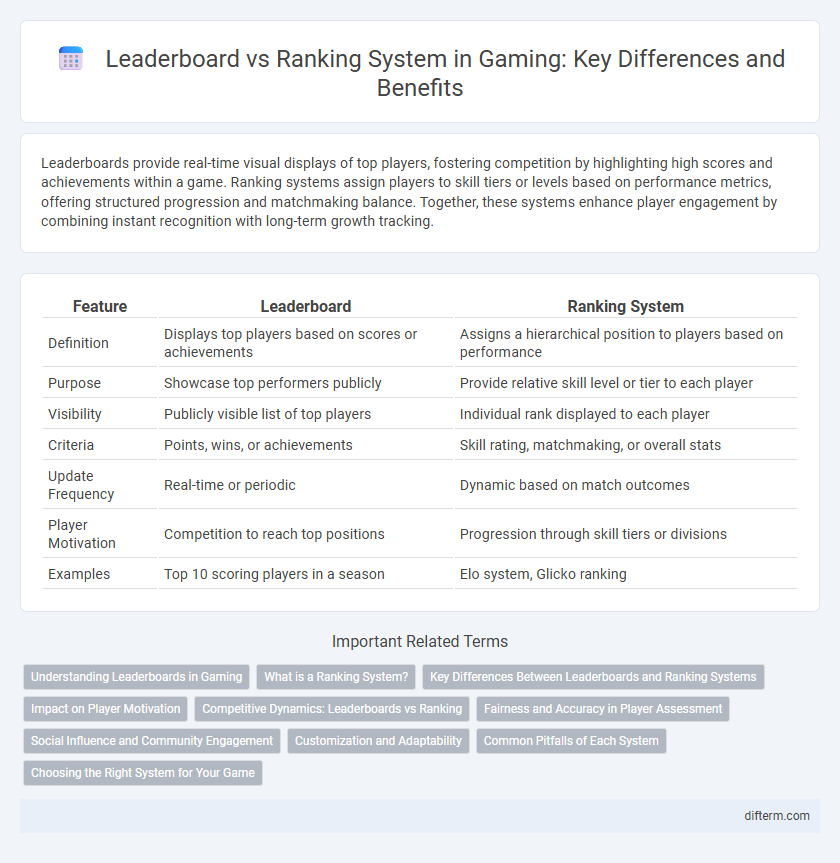Leaderboards provide real-time visual displays of top players, fostering competition by highlighting high scores and achievements within a game. Ranking systems assign players to skill tiers or levels based on performance metrics, offering structured progression and matchmaking balance. Together, these systems enhance player engagement by combining instant recognition with long-term growth tracking.
Table of Comparison
| Feature | Leaderboard | Ranking System |
|---|---|---|
| Definition | Displays top players based on scores or achievements | Assigns a hierarchical position to players based on performance |
| Purpose | Showcase top performers publicly | Provide relative skill level or tier to each player |
| Visibility | Publicly visible list of top players | Individual rank displayed to each player |
| Criteria | Points, wins, or achievements | Skill rating, matchmaking, or overall stats |
| Update Frequency | Real-time or periodic | Dynamic based on match outcomes |
| Player Motivation | Competition to reach top positions | Progression through skill tiers or divisions |
| Examples | Top 10 scoring players in a season | Elo system, Glicko ranking |
Understanding Leaderboards in Gaming
Leaderboards in gaming provide a dynamic, real-time display of player performance, showcasing top scores and achievements to foster competition and motivation. Unlike static ranking systems, leaderboards update frequently based on ongoing player activities, offering immediate feedback and encouraging continuous engagement. This transparency and visibility of player standings enhance social interaction and drive skill improvement within gaming communities.
What is a Ranking System?
A ranking system in gaming assigns players positions based on their performance metrics, such as score, wins, or skill level, creating a dynamic hierarchy that reflects competitive progress. Unlike a leaderboard that typically displays top players, a ranking system often incorporates tiers or divisions, providing detailed insight into player skill distribution across the entire player base. This structured approach enhances matchmaking accuracy, player motivation, and overall game balance.
Key Differences Between Leaderboards and Ranking Systems
Leaderboards display player scores or achievements in real-time order, emphasizing immediate competition and visibility among all participants. Ranking systems assign players a skill level or tier based on performance metrics over time, prioritizing long-term progression and matchmaking accuracy. Unlike leaderboards that foster direct competition, ranking systems provide a structured evaluation that adapts to evolving player skills.
Impact on Player Motivation
Leaderboards provide real-time feedback and foster competitive spirit by showcasing top players, significantly boosting motivation through public recognition. Ranking systems offer structured progression, encouraging sustained engagement by rewarding incremental improvements and skill mastery. Combining both elements maximizes player motivation by appealing to social comparison and personal achievement drives.
Competitive Dynamics: Leaderboards vs Ranking
Leaderboards and ranking systems both drive competitive dynamics by showcasing player performance, but they differ in real-time visibility and motivational impact. Leaderboards provide an immediate, visible snapshot of top players, fostering short-term competition and social recognition. Ranking systems, often based on skill ratings or match outcomes, offer a more nuanced, long-term progression metric that incentivizes consistent improvement and fair matchmaking.
Fairness and Accuracy in Player Assessment
Leaderboards and ranking systems both aim to measure player skill, but ranking systems typically provide higher fairness by factoring in variables such as opponent skill and match history, resulting in more accurate player assessment. Leaderboards often rely on raw scores or cumulative points, which can lead to skewed representations favoring frequent players rather than consistently skilled ones. Advanced ranking algorithms like Elo or TrueSkill adjust dynamically, ensuring that player skill levels are compared more precisely across diverse match conditions.
Social Influence and Community Engagement
Leaderboards provide real-time visibility of player achievements, fostering competition that drives social interaction and enhances community engagement. Ranking systems offer long-term progress tracking, motivating players to invest time and build reputations within the gaming community. Both mechanisms boost social influence by encouraging collaboration, discussion, and the formation of gaming networks.
Customization and Adaptability
Leaderboards offer limited customization, primarily displaying fixed metrics like points or wins, whereas ranking systems enable adaptable criteria tailored to diverse game modes and player preferences. Ranking systems adjust dynamically to player skill, promoting fair competition and enhancing user engagement through personalized progression paths. Customizable ranking frameworks support varied gameplay styles, fostering inclusivity and sustained motivation across different player demographics.
Common Pitfalls of Each System
Leaderboards often suffer from lack of meaningful context, as they primarily showcase top scorers without reflecting individual progress or skill diversity, which can demotivate new or less competitive players. Ranking systems may fall into pitfalls like inflated ranks due to matchmaking imbalances and manipulation through exploitation of point mechanics, leading to inaccurate player skill representation. Both systems require careful calibration to maintain fairness, player engagement, and competitive integrity in gaming environments.
Choosing the Right System for Your Game
Selecting the appropriate system between leaderboard and ranking depends on your game's goals and player engagement style. Leaderboards excel in dynamic tracking of top scores, enhancing competitive motivation through visibility in fast-paced or casual games. Ranking systems offer a structured progression framework, ideal for games emphasizing long-term growth and skill development by categorizing players into tiers or divisions.
leaderboard vs ranking system Infographic

 difterm.com
difterm.com